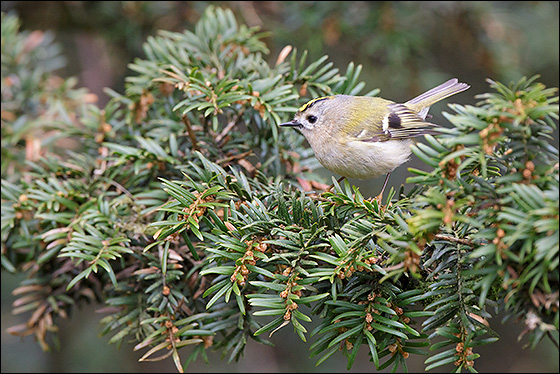Goldcrest (Regulus regulus)
Despite its size the Goldcrest is primarily found in the north of Europe. Here, after all, is the greatest abundance of conifers, although on the other hand the winters are long and harsh. Goldcrests do evacuate some of their more extreme haunts from October onwards, especially those inside the Arctic Circle, but some can still be found all year beyond 65°N. Experiments, indeed, have shown that even when it is -25°C outside Goldcrests can maintain their internal body temperature of 39-41°C for 18 hours, so long as they can obtain enough food and can huddle up to another Goldcrest at night. But in order to survive they must simply feed all day without stopping.
Goldcrests eat mainly insects and other arthropods of various sorts, especially the smallest up to about 40 mg in weight. These include scale insects, aphids, flies and mites, for example, although many other groups have been recorded as well. The thin bill of the Goldcrest is specially designed to take these small bodied creatures from confined spaces.
Goldcrests also have special adaptations for breeding in less than kind climates. The nest, for example, is an ample cup of three layers suspended from a twig. The outer layer is made up from a mixture of cobwebs, moss and lichens, and inside this is another layer of moss and lichen. Finally, for the lining, the birds stuff feathers in, often in large quantity. A few of these feathers are specially fixed in to form a sort of umbrella over the entrance, trapping the warm air inside. The entrance itself is rather narrow, and often placed flush against the twigs from which the nest is suspended. All in all, the nest is well designed to keep out the cold.
Despite their audacity in the face of conditions that would make most small birds evacuate, Goldcrests do inevitably suffer in the very worst conditions. Mortality is high, and small groups of Goldcrests that form in the winter and hold their own communal territory often dwindle to trios or pairs by the following spring. Nonetheless, the Goldcrest is a highly productive species, capable theoretically of bringing up two broods of 9 chicks in a season, so any losses are soon made up. Goldcrests ensure that they can raise two broods in the short northern season by overlapping them. Both sexes build the first nest together, and while the female is incubating the first brood the male builds a second structure. The eggs hatch and both adults feed the chicks at first, but this soon changes as the female moves to the second nest and lays a second clutch while the male takes over sole responsibility for feeding the first brood. Once these are independent he joins the female in feeding the second clutch, and the division of roles ceases.
Despite its size the Goldcrest is a fearless and pugnacious bird. Where two rivals meet they don’t necessarily exchange pleasantries, but instead ruffle their respective crown feathers to show off the pleasing yellow and orange coloration, flick their wings and bob their heads. This showing off of the colourful crown is something of a universal display among these birds, for something very similar takes place, too, when male and female meet.

